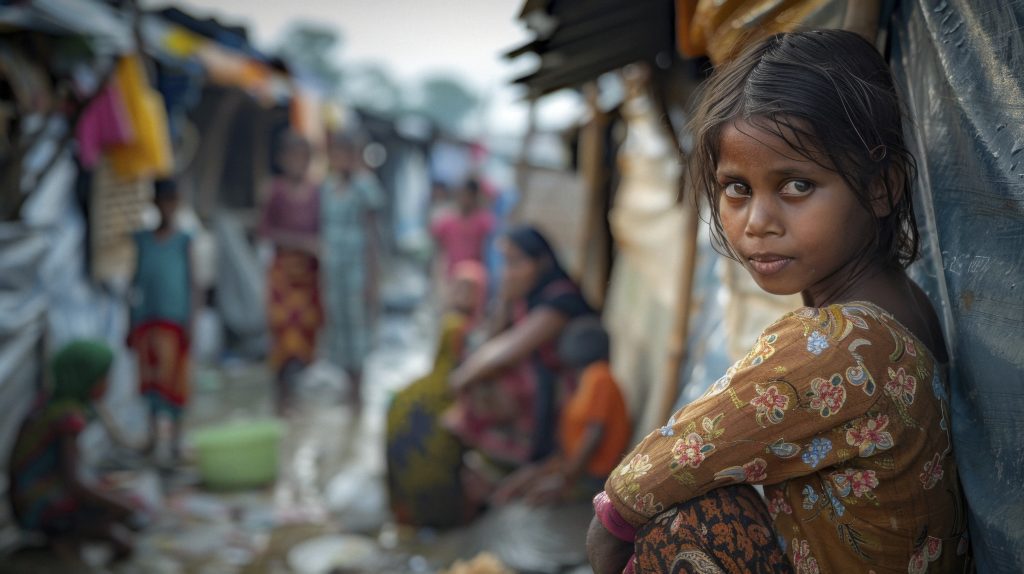Gavi 2025: What a $9Bn Pledge Means for the World

What does a $9B pledge mean for vaccines, health equity, and the future of global immunisation? Discover the key takeaways from the Gavi Summit.
Low Fertility Rate Is Not The Crisis — Inequality Is

A Women’s Reaction to the Real Global Fertility Rate Crisis By Chinasa Imo | What About Rural Health? Global Fertility Rate Is Falling — But That’s Not the Whole Story The global fertility rate is on the decline. According to the UNFPA’s 2025 State of World Population Report, the global average now sits at 2.2 births per woman—down from 5 in the 1960s. By 2050, it’s expected to fall below the replacement level of 2.1. But here’s the critical point: the crisis isn’t that people are choosing smaller families. It’s that millions are unable to have the number of children they want—because of poverty, healthcare gaps, and systemic inequality. The Real Crisis? Reproductive Agency UNFPA surveyed 14,000 people across 14 countries and found that: “1 in 4 people haven’t had or expect they won’t have their desired number of children.” It’s not biology that’s the problem—it’s barriers. 257 million women worldwide want to avoid pregnancy but lack access to modern contraception (UNFPA, 2025).This isn’t a personal shortcoming — it’s a systemic failure. That’s where the popular “fertility crisis” narrative falls apart. It assumes people are making free, empowered choices — but for many, that freedom doesn’t exist. Take Namrata, a working mother in Mumbai, whose story was featured by the BBC. She and her husband hoped for a second child, but the high costs of raising just one — from healthcare to school fees — made that feel out of reach. Her experience mirrors findings from the UNFPA survey, where the most common reasons for not having more children were: lack of money, lack of time, and lack of support. When policymakers say, “people are choosing to have fewer children,” we need to pause and ask: is it truly a choice? Because the data tells a different story: Many are having fewer children than they would like — not out of preference, but due to financial strain and structural barriers. Others are having more than they intended — because they lack access to contraception and control over their reproductive lives. In both cases, the common thread is a loss of agency. It’s not just about birth rates — it’s about whether people can actually decide for themselves. In Rural Communities, Fertility Rate has a Grim Face In remote areas of countries like Nigeria, India, and South Africa, women face compounding obstacles: Long distances to clinics High maternal and infant mortality rates Limited contraceptive options Child marriage and low educational opportunities And while urban discussions focus on fertility incentives and work-life balance, rural women are still fighting for access to basic healthcare. You can’t make empowered choices when you’re facing gender-based violence, malnutrition, forced marriage, and poverty every day. In such conditions, “choice” is an illusion. While sub-Saharan Africa hasn’t reached below-replacement fertility, early shifts are emerging due to urbanization, increased education, family planning access, and gender equality efforts—contributing to a gradual, organic decline. The takeaway? Behind every data point is a real story. And behind every fertility decline is a system.Instead of asking how many children women are having, we should be asking: why are they having fewer—or none at all? Stop Treating Women as Birthrate Solutions Countries like Hungary, South Korea, and China are now offering cash incentives and launching pro-natalist campaigns to boost birth rates. But this approach misses the mark. Rather than creating inclusive systems that respond to what women actually need, these governments are pressuring women into motherhood (Lee, 2025; Friedman, 2024; Kwon, 2024; Tan, 2023). Policies rooted in panic will always fall short.True reproductive justice means building systems of care that support informed, empowered choices—whether that’s having children, not having them, or choosing to wait. Fertility support should begin with rights, not rewards. More: Why Hungary’s Subsidies Failed Saying “No” Can Be a Powerful Act One of the most powerful insights from the UNFPA report is this: many women aren’t avoiding children because they don’t want them—it’s because the system makes it too risky. For some, choosing to stop at one or none isn’t apathy—it’s survival. As a woman in the Philippines put it: “A lot of policies are against women’s healthcare. It pushes us to stay single and have no children.” (UNFPA, 2025, p. 9) When systems fail—through violence, poverty, or inadequate care—women don’t give up. They opt out to protect themselves.This policy feedback loop is not apathy; it’s risk management. Reframe the Narrative: Fertility Should be About Choice Rather than crafting policies to manipulate fertility rates, we need to shift the focus to what truly matters: supporting women to thrive. When women—especially in rural communities—feel safe, heard, and supported, they make choices that benefit their families and society. The real issue isn’t low birth rates. It’s that too many women still lack the agency to make life-defining decisions about their bodies and futures. What’s needed are policies that trust women, invest in health systems, and create conditions where reproductive autonomy is not the exception—but the norm. At WhatAboutRuralHealth?™, we believe the solution isn’t more babies. It’s more support, options, and freedom. Rural women must be at the center of reproductive health conversations—not as passive recipients or population targets, but as leaders. They deserve dignity, care, and platforms to be heard. That means: More investment in rural health systems More protection from gender-based violence More clinics More spaces—like this one—for rural women to speak their truth Because the real fertility crisis isn’t about numbers. It’s about equity.True progress is when every woman can say:“Yes, I want a child.”“No, not right now.”“This is enough for me.” What You Can Do Reproductive justice = reproductive choice. If you’re a health worker, policy expert, or rural community member, we want your voice in this conversation. Submit your rural health story here Join our volunteer collective References UNFPA State of World Population Report 2025 BBC: The Real Fertility Crisis CBS News: Korea’s Parenthood Incentives Financial Times: Hungary’s Demographic Policies
Rural Health: This Campaign Is Urgent

by Elijah Nsikak In the heart of rural communities worldwide, a quiet crisis unfolds daily. From limited access to healthcare services to health disparities, underserved populations face unique challenges often overlooked in broader health discussions. As we launch our campaign, it’s imperative to highlight these issues and understand why immediate action is essential. The Rural Health Landscape: A Global Perspective Rural areas are home to approximately 46 million people in the United States alone, accounting for about 15% of the population . Globally, billions reside in rural settings, often with limited access to essential healthcare services. These communities frequently experience higher rates of chronic diseases, mental health issues, and maternal and infant mortality compared to their urban counterparts. Disparities in Healthcare Access One of the most pressing issues in rural health is the shortage of healthcare professionals. In the U.S., as of September 2024, 66.33% of Primary Care Health Professional Shortage Areas (HPSAs) were located in rural areas . India: In Maharashtra’s Jalgaon district, a woman was forced to deliver her baby on the roadside due to the unavailability of ambulance services . This incident highlights the dire state of rural healthcare infrastructure in parts of India. China: In rural China, David Wei had to carry his nephew on his back for 3 kilometers (1.9 miles) along a rough, under-construction road after the young man suffered a heart attack—while they waited 90 minutes for an ambulance to arrive from the city. Shortage of healthcare providers means that rural residents travel long distances for medical care, leading to delayed diagnoses and treatment. This barrier is exacerbated by limited transportation options and inadequate infrastructure. Socioeconomic Factors and Health Outcomes Disadvantaged communities often grapple with socioeconomic challenges that directly impact health outcomes. Higher poverty rates, lower educational attainment, and limited employment opportunities contribute to poorer health status among rural populations. These factors also influence lifestyle choices and access to health-promoting resources, leading to higher incidences of obesity, smoking, and physical inactivity. Consequently, residents of rustic areas are at an increased risk for conditions such as heart disease, diabetes, and many more health risks. The Impact of Hospital Closures Over the past decade, rural hospitals have been closing at an alarming rate. In the U.S., more than 130 rural hospitals have shut down since 2010, with financial constraints and low patient volumes cited as primary reasons . These closures not only limit access to emergency and specialized care but also have broader economic implications, including job losses and decreased community investment. The Role of Technology and Telehealth Telehealth has emerged as a potential solution to bridge the healthcare gap in rural areas. However, the effectiveness of telehealth is contingent on reliable internet access, which remains a significant hurdle. A KFF analysis found that nearly 3 million Americans live in areas lacking both healthcare and reliable high-speed internet, hindering telehealth services. The Urgency for Policy and Advocacy Addressing rural health disparities requires concerted efforts from policymakers, healthcare providers, and community organizations. Strategies include incentivizing healthcare professionals to practice in these areas, investing in infrastructure, and tailoring public health initiatives to meet the unique needs of rural populations. Moreover, incorporating the voices of residents in low-resourced communities policy development ensures that interventions are culturally appropriate and effectively address the specific challenges these communities face. Join the Movement Our campaign aims to spotlight the pressing issues in rural health and advocate for sustainable solutions. By raising awareness, sharing stories, and promoting evidence-based policies, we strive to create a more equitable healthcare landscape for all. We invite you to be part of this movement. Together, we can make a difference. Read about the $9Bn pledge for global health
AHA announces recipients of 2024 Rural Health Leadership Award

The AHA today announced the team from Columbia Memorial Hospital, a critical access hospital in Astoria, Ore., is the 2024 recipient of the Rural Hospital Leadership Team Award. The award recognizes rural hospital leaders who guide their hospitals and communities through change and innovation. Also recognized as finalists were teams at Atrium Health Lincoln in Lincoln, N.C.; Schneck Medical Center in Seymour, Ind.; and Summit Pacific Medical Center in Elma, Wash. The award will be presented at the 38th annual AHA Rural Health Care Leadership Conference, taking place Feb. 23-26 in San Antonio.
Investing in health tech to transform rural healthcare in Africa

Go to any village across this continent, and the struggle for decent healthcare is real. Mothers lose children, families watch loved ones suffer needlessly, and communities are trapped in a cycle of sickness. We talk about fundamental human rights, but for millions in our rural areas, quality healthcare is a pipe dream. The roads are bad, clinics are understaffed, and even when there is a clinic, affording treatment is another hurdle altogether. But I believe health data technology offers a real opportunity to change this narrative. It’s not a magic bullet, but a way to make real progress in these underserved communities. “Digitisation reduces administrative burden, freeing up time for patient care.” Challenges on the digital frontier The internet situation in many of our rural areas is patchy at best and non-existent at worst. Transferring medical records, conducting telemedicine consultations, and using remote monitoring devices are impossible with such unreliable connectivity. This is the biggest hurdle we face when bringing these technologies to the people who need them most. And it’s not just the internet. We’re struggling to find enough doctors and nurses to staff our rural clinics because our bright young graduates, those with the skills, flock to the cities for better urban opportunities. Recruiting talent to rural areas is a tough sell. It’s a real brain drain, and it’s crippling our efforts to bring quality healthcare to these communities. Our rural clinics are already running on fumes. Their budgets are stretched thinner than ever. These technologies come with a hefty price tag. For many of these facilities, the upfront costs alone are enough to make their heads spin. They simply can’t afford the improvements they need without significant financial assistance. Even with infrastructure, expertise, and funding, technology adoption requires user comfort. Digital literacy is low in many rural communities. Simply providing the technology isn’t enough; we must invest in training, education, and personalised guidance to build trust. Otherwise, it’s just expensive equipment gathering dust. Benefits of health data technology Despite all these hurdles, the potential here is absolutely huge. Electronic health records provide a complete patient history for doctors and nurses. And telehealth transforms access to care, especially for remote patients unable to travel. Currently, rural patients often experience fragmented care, with limited information sharing between local doctors and city specialists. These systems facilitate seamless information sharing between healthcare providers. Telehealth expands access to specialists. Our healthcare workers are drowning in paperwork. Digitising records changes all that. Digitisation reduces administrative burden, freeing up time for patient care. This data has immense potential. It can help us track diseases, understand health trends, and develop targeted public health interventions. Regulatory considerations Careful consideration of regulations is essential. Data privacy is paramount. Regulations like the Health Insurance Portability and Accountability Act (HIPAA) exist for a reason. We need to ensure that our healthcare facilities have the right security measures in place: secure storage, encryption, access controls, and robust security. We also need to understand the specific regulations around telehealth. Telehealth regulations and reimbursement must be understood. Innovative solutions Closing this healthcare technology gap is going to take a concerted effort on multiple fronts. We have to tackle this broadband issue. Reliable rural internet access is essential. Public-private partnerships are also essential. Both the government and the private sector must invest in infrastructure. And while we’re building out the infrastructure, we need to aggressively promote telemedicine and telehealth. Robust telehealth programs are critical. Practical, tailored training is essential for effective technology use. IT specialists are equally critical. Local IT expertise must be developed. Mobile clinics can bring healthcare to remote communities. Community health workers are critical for education and trust-building. Funding through public-private partnerships and grants is essential. The human element Technology is just a tool. We have to engage with our communities, understand their needs, and empower them to take ownership of their health. Solutions must be based on community needs. We need to establish feedback mechanisms. Awareness campaigns are essential for technology adoption. Robust awareness campaigns (e.g., community workshops, training sessions, health fairs) are needed. Patient empowerment through data access is essential. Education on telehealth benefits is also critical. The digital divide must be addressed. We have to address this digital divide head-on. Local champions are key to adoption. Local community leaders must be engaged. Improving rural healthcare is a long-term endeavour. Addressing infrastructure, skills, and funding gaps is essential. Community engagement and empowerment are critical. If we do all these things, we can build a future where quality healthcare isn’t a privilege for the few, but a fundamental right for every single person, no matter where they live. About the author: Ota Akhigbe is a results-oriented leader with over 16 years of experience driving impactful change across diverse sectors in Africa, including healthcare, infrastructure development, and financial inclusion. She is passionate about leveraging technology and building strategic partnerships to improve access to quality services and enhance community well-being.
